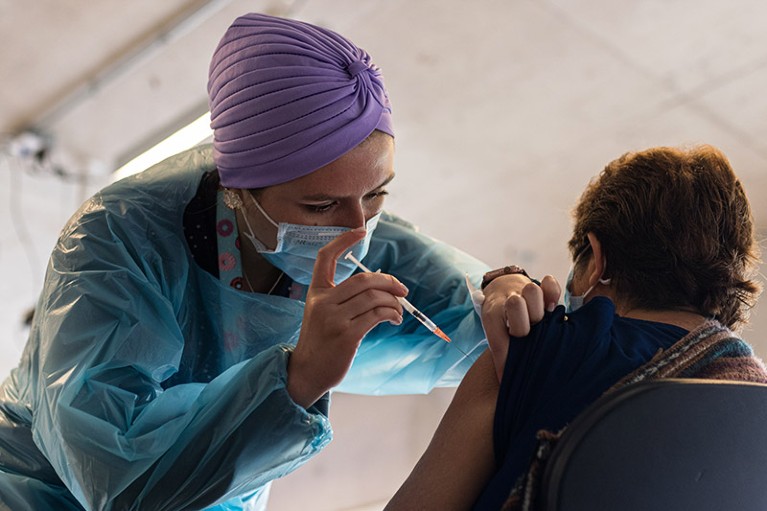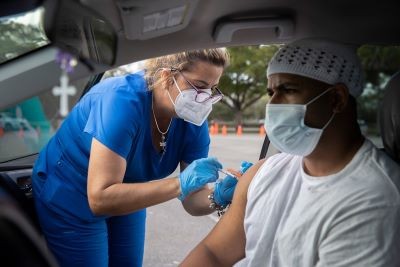
A health worker gives a fourth booster vaccination for COVID-19 to a person in Viña del Mar, Chile.Credit: Lucas Aguayo/Zuma Press/Avalon
Confronted once again with waning immunity against SARS-CoV-2, health officials around the world are planning to roll out booster jabs in the next few months. But these booster campaigns might not have the same come-one, come-all approach of previous years.
Now that the COVID-19 global emergency is over and infections have dwindled, officials have been rethinking who should receive the jab and when. Some countries have already restricted access to current boosters so they are available only to people at high risk of severe disease or death, and several nations have hinted that updated boosters rolled out in the coming months will be reserved for vulnerable individuals.
Health officials note that many people are still protected against severe disease by either previous infection, vaccination or both. That protection, combined with pandemic fatigue and a relatively low level of hospitalizations and infections “has put us in a different era, and we need different approaches”, says Annelies Wilder-Smith, a vaccinologist at the World Health Organization (WHO) in Geneva, Switzerland.
But a few countries contend that boosters should be administered to almost all age groups, and some scientists argue that broad vaccination campaigns can help to protect vulnerable people.
Fading immunity
Since late 2022, many countries have been offering ‘bivalent’ boosters that target both the original strain of the SARS-CoV-2 coronavirus and an early Omicron strain. These vaccines have protected against severe disease and death, but the boost in immunity they confer wanes quickly: data from the US Centers for Disease Control and Prevention (CDC) show that protection against hospitalization dropped from 62% in the first 2 months after the jab to 24% after 4 months1.
New Omicron-specific vaccines offer similar protection to existing boosters
To boost immunity before an anticipated spike of infections during winter in the Northern Hemisphere, officials are gearing up to launch another booster campaign. Vaccine manufacturers are preparing an updated ‘monovalent’ jab targeting a single, recent Omicron subvariant. This subvariant is expected to be more similar to the strain circulating when the jabs are being rolled out than to the strains that last year’s bivalent vaccine targeted.
But public enthusiasm is waning alongside immunity: uptake of every successive booster has decreased. Only about 17% of people in the United States have received a bivalent jab, and some 14% of people in European Union countries have received a second booster. This tepid acceptance rate — and its potential to affect vaccination campaigns against other illnesses such as polio — has played a part in how officials are planning for the next booster campaign, Wilder-Smith says.
“The fear factor is gone,” she says. “You have to be smart as a policymaker with limited resources as to how to maximize the COVID-19 booster impact.”
Dialling back
On the basis of these factors and the current trajectory of the pandemic, a WHO subgroup recommended in March that high-risk groups, such as older adults and health-care workers, should continue to receive boosters routinely. But the guidelines do not recommend routine boosters for healthy adults under 60 who’ve already had one, noting the “comparatively low public health returns”.
Nor do the guidelines wholeheartedly endorse COVID-19 vaccines for healthy children, including those who have not yet been vaccinated. The vaccine’s benefit to children, the WHO says, is “substantially lower” than the benefit from other childhood jabs, such as for measles.
Although health authorities have repeatedly affirmed the safety of COVID-19 booster jabs, extra ones are “low risk, low benefit for otherwise healthy people”, says Paul Offit, a paediatrician and vaccine specialist at the Children’s Hospital of Philadelphia in Pennsylvania. Offering the vaccine to a broader population than is necessary not only wastes resources, he argues, but also risks undermining influenza vaccinations, which are much more clearly beneficial to all age groups compared with the COVID-19 booster.
Over-50s only
Some nations have already taken this thinking to heart. In February, for example, officials in the United Kingdom stopped offering boosters to healthy people under 50. Many other countries in Europe, including France and Sweden, have similar restrictions on booster distribution and are likely to follow the same course for autumn monovalent boosters.
Kids show mysteriously low levels of COVID antibodies
By contrast, US officials have continued to offer boosters to just about everybody, including children aged 6 months and older. (It is unclear whether the CDC will recommend the monovalent jab for all; the agency will issue a decision in the coming months.) In a similar vein, Japanese officials have announced a plan to offer another booster between September and December to healthy people aged 5 and older — and potentially every year.
Health specialists say such a programme has merit. With this approach, “you reduce the likelihood of spreading the infection to loved ones”, says Ofer Levy, a vaccinologist at Boston Children’s Hospital in Massachusetts. “You take infections that might have been moderate and you make them mild. You take something that would have been severe and life-threatening, and you make it mild to moderate.”
Although WHO guidelines stipulate that healthy children and young adults are among the lowest priority groups for COVID-19 vaccination, Wilder-Smith says that the Japanese and US approaches are reasonable, because the jabs do provide some benefit — even if it is short-lived.
Not the flu
Plans to roll out updated boosters across the population every autumn would echo programmes for flu vaccination, which is also recommended for most children and adults. But some scientists argue that the parallel is unwarranted, because unlike the flu jab, COVID-19 vaccines have so far provided robust protection against severe disease and death across multiple SARS-CoV-2 variants.
All of these recommendations hinge on the virus continuing to evolve in the same way it has done for the past 18 months. “Ever since Omicron, there has been a more linear evolution of new variants that are linked back to the original Omicron,” says David Ho, a virologist at Columbia University Irving Medical Center in New York City. “But we can’t anticipate what we don’t know — there could be a surprise variant that emerges in the coming months.”









More News
Author Correction: Stepwise activation of a metabotropic glutamate receptor – Nature
Changing rainforest to plantations shifts tropical food webs
Streamlined skull helps foxes take a nosedive